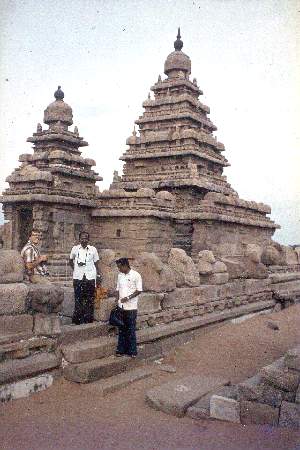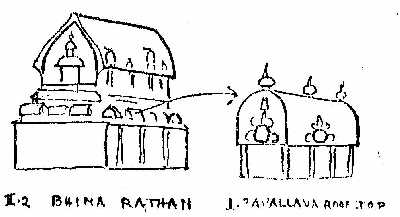

Home | Biodata | Biography | Photo Gallery | Publications | Tributes
Archaeology

 |

Home | Biodata | Biography | Photo Gallery | Publications | Tributes Archaeology |
 |
The gopuram (Fig. 1.5) is the tower built over the gateway, and the familiar towers of Madurai are gopurams. The base of the gopuram is rectangular in shape. Vimanam (Fig. 2.6) is the tower built over the central shrine in a temple and it has a square base. The tower of the Big Temple at Tanjore is a good example of the Vimanam. There is a tall tower in the Tanjore Palace which resembles the Big Temple Vimanam in shape but this tower was built by the Naicks as an armoury.
The beginnings of the Gopuram and the Vimanam can be seen in the rock-cut temples of Mahabalipuram and the growth of the shapes of the temples at Mahabalipuram can be easily traced (from the shapes of simple thatched huts. The topmost part of the Vimanam is called Kalasam (Fig. 2.6) and the Gopuram has several Kalasams in a row. The Kalasam is fixed on the Sikharam (Fig. 2.6) or the crown of the tower. The next feature is the Koodu (Fig. 2.6) or window. The Koodu in the early structures shows the face of a man at the centre, but in the modern forms, other designs have replaced the face.
Consider a hut with thatched roof and rectangular base with the roof sloping on two sides (Fig. 1.1). This thatched structure may or may not be surrounded by walls. The horizontal bar at the lop of the roof is supported by several vertical bamboo poles. Bamboo seeds were used as staple food during the Sangam period and bamboo poles, therefore, were easily available from the early days. The top of the poles that were sticking out, were covered by inverted mud pots as it is done today near Mahabalipuram. To make openings on the broad side of the structure, a small inverted V-shaped arch was constructed and covered with thatch as it is done today.
The thatch-roof pattern is the prototype of the Gopurarn and the Vimanam found today in Madras State, and the earliest available evidence of the ' Tamilian Style ' of architecture is found at Mahabalipuram. In the process of adapting the thatch-roof pattern to stone and other permanent materials, new forms were evolved. Bhima ratham (Fig. 1.2) and Ganesa ratham are examples of the hut-shaped structures with rectangular base and two sloping roofs. When more storeys are added, the shape evolves into that of the modern Gopuram as shown in Figures 1.1 to 1.5. Some of the Kalasams of the rock temples are missing and some others can be found lying around. An enthusiast must have replaced the fallen Kalasams by a worn-out Nandi, on a roof-top on the Shore Temple at Mahabalipuram (Fig. 2.5) and it must have been quite a job lifting up the Nandi to that place !
Consider a hut with a square base and the thatched roof sloping on all four sides. This is the prototype of Draupathi ratham (Fig. 2.2) which is actually a Durga temple. This shape is transformed to another similar shape when the curvature of the roof is increased, keeping the base square. This shape is that of the Sikharam of the early Vimanam and it is found at Mahabalipuram on several rathams and panels. The square base of the Sikharam was changed into octagonal shape first and then into circular. When a few storeys are added, one gets the Dharmaraja ratha shape, which grows into the huge Tanjore Vimanam shape as more stories are added on.
| THE EVOLUTION OF THE GOPURAM AND THE VIMANAM | ||
|---|---|---|
 |
 |
|
 |
 |
 |
 |
 |
 |
 |
 |
 |
 |
 |
 |
 |
 |
|
We have taken so far the rectangular based thatched roof with two sides alone sloping. If it begins with three sloping sides, it is possible to arrive at the Gajaprishtam type of Sikharams found at Thirusulam (Fig. 4.2) near Pallavaram and at the Sahadeva ratham at Mahabalipuram. If the four sides are sloping, then we get a shape which is a combination of the Draupathi and Bhima rathams, but with a rectangular base. Such a thatched roof is found in the recently discovered Chola paintings at Tanjore (Fig. 3.2). It may also evolve into a Sikharam with a base made up of two semicircles and a rectangle. Such an example can be seen in a small shrine at the Mylapore Temple (Fig. 3.3).
We have shown the evolution of the Gopuram and the Vimanam of the ' Tamilian Style ' of architecture, without assuming the direct influence of ' Buddhist ' architecture from North India. We have used as evidences for our arguments the common huts with thatched roofs and bamboo poles, the Chola painting from Tanjore Temple and the early monuments of Mahabalipuram. However, the author does not wish to claim that the process of evolution as given here need be historically true!